Genus Agave
English names: agave, century plant
Spanish names: mezcal, mescal, maguey, amole (general names that vary by region and use of the plant)
Agaves are among the most conspicuous plants of arid North America; their bold forms attract attention in any landscape whether natural or designed. All are characterized by succulent or semisucculent leaves that form rosettes from a few inches to several feet across, but there are many variations on this basic pattern. Most species are essentially stemless but a few grow trunks that creep along the ground. Some species have only one rosette; most multiply by underground suckers and may develop into large colonies. Agave leaves vary from green through bluish to silver-gray, and are often strikingly banded with different shades of color. Leaves range from long and narrow to short and broad, and from arrow-straight to gracefully recurved or haphazardly twisted. The leaf margins are typically lined with large, sharp spines (teeth) and each leaf is usually tipped with a hard, sharp spine. A few species have leathery, unarmed leaves. The leaves are so tightly compacted in the growing tip that the teeth leave imprints on both surfaces of adjacent leaves after they unfurl, overlaying their own complex patterns over the banding. These imposing features make agaves popular among succulent collectors and landscape designers.
Various agave species have also been and continue to be important sources of food, fences, rope, medicine, and liquor. The Mescalero Apaches were named for their dependence on this plant. Before them the Hohokam cultivated agaves as a major food crop (see A. murpheyi).
Agaves flower on tall, branched or unbranched stalks that grow from the center of the leaf rosette. As a plant approaches maturity at 10 to 30 years of age it accumulates a great quantity of sugar and starch in the heart tissue. These carbohydrates provide the energy that fuels the rapid development of the inflorescence (the flowering structure, including supporting stems), which is usually massive compared to the plant that produces it. In all but a few species the rosette dies after flowering and fruiting, having spent all of its life energy to produce a huge quantity of seeds-a monocarpic (once-fruiting) life cycle. The plants literally flower themselves to death.
Though the flowering rosette usually dies, many species produce vegetative offsets (suckers or pups in English, hijos or "sons" in Spanish) before or after flowering. In this way clones (multiple, genetically identical, individuals that originated from a single original seed) form colonies that may persist for centuries or longer.
Range
The genus ranges from Utah in western North America through Mexico (where the most species are found), with a few in northern South America and on Caribbean Islands. The majority of agave species occur in semiarid habitats above the desert, especially in desert grasslands and oak-pine woodlands. About 40 of the 150 North American species occur in the Sonoran Desert region.
Ecology
Agaves typically grow on well-drained, rocky slopes. Different species are adapted for pollination by insects, nectar-eating bats, and hummingbirds. Seeds are dispersed by wind, usually only a short distance from the parent.
The two major groups, or subgenera, of agaves are distinguished from each other by whether their inflorescences are obviously branched or not. Most species in the subgenus Agave (branched inflorescences) developed features that enable them to be pollinated by nectar-feeding bats, although other pollinators may currently be more important. They grow whitish to yellow flowers which produce copious nectar and pollen at night. Bats are attracted by the fragrant nectar, which usually smells unpleasant to humans-like ammonia or rotting fruit, depending on the species. Agave nectar and pollen are major food sources on the northernmost and southward legs of the bats' migratory routes. After wintering in the Mexican tropics, bats migrate northward through the desert following the south-to-north wave of spring-blooming columnar cacti. They raise their young in southern Arizona, then return south via the mountains, feeding on agaves. Hawk-moths are also common visitors to the night-flowering agaves and are probably effective pollinators; bees and other diurnal insects aid in pollination as well.
Some species in the subgenus Agave occur outside the range of the bats, or flower at a season when the bats are not present. These have colored diurnal flowers that are pollinated by hummingbirds and bees. Species in the subgenus Littaea (which bear unbranched spikes) are pollinated mainly by insects and sometimes hummingbirds.
Of the 40 or more agaves in our region, several are ecologically or horticulturally important. Agave americana, a very large plant with rosettes up to 12 feet (3.7 m) broad, is by far the most commonly used in gardens in the southwest U.S. and worldwide, although most of its natural range is outside the Sonoran Desert region. In our species accounts, we focus on some of the more interesting local species.
Ethnobotany
Several beverages are made from the sugar-rich juices of mature agaves. The extracted juice is drunk fresh as aguamiel (honey-water) or fermented into pulque; both are popular beverages south of the Sonoran Desert. Steamed heads or central stalks are mashed and allowed to ferment with added liquid. After several days, the resulting fluid is distilled into the potent liquor mescal. The most widely known local ("bootleg") variety of mescal is Bacanora, named after that Sonoran town and made from Agave angustifolia. Other varieties of bootleg mescal are made in nearly every Mexican village within agave habitat. Tequila, the most famous legal variety of mescal, is made from the single species Agave tequilana, grown near the town Tequila in Jalisco. Tequila is to mescal much as Chardonnay is to wine.
Mature agaves also provide food. The leaves are cut off near their bases, leaving a cabeza ("head") resembling a giant pineapple, weighing up to 70 pounds (32 kg). The cabezas are usually pit-roasted in large numbers and eaten during fiestas. (Note: The raw flesh of many agaves is caustic and can even blister skin.)
Agave deserti
English name: desert agave
Spanish name: amul
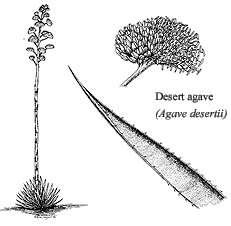
Description
This is a small species with rosettes rarely over 1¼ feet (0.5 m) in diameter. The leaves are nearly straight and light gray to bluish-gray, with marginal teeth. Most varieties sucker near the base to form dense colonies, but some offset by long underground rhizomes, and a couple of forms rarely offset at all. The branched inflorescence bears bright yellow flowers that are attractive to hummingbirds. Some populations have red buds, which contrast beautifully with the flowers.
Range
One of the most desert-adapted agaves, it is native to rocky or gravelly soils in the Lower Colorado River Valley subdivision of the Sonoran Desert. Its range extends barely into Arizona Upland and the Mohave Desert.
Comments
Agave deserti is a very slow-growing species; even in cultivation with generous irrigation it takes at least 20 years to flower. As spent rosettes of wild plants die and decompose, new ones replace them on the outer margin, eventually forming ring-shaped colonies. Rings 20 feet (6 m) in diameter in California's Anza-Borrego Desert State Park may be more than a millennium old. One of the more edible agaves, Agave deserti has been extensively harvested by desert peoples.
In Baja California this species can be confused with the straight-leaved varieties of Agave cerulata, which also grows in extreme desert habitats. Agave chrysantha is larger with golden-yellow blossoms; it descends into the higher elevations of Arizona Upland in south-central Arizona. This is the most frequently-encountered agave on the northeastern boundary of the Sonoran Desert north and east of both Phoenix and Tucson.
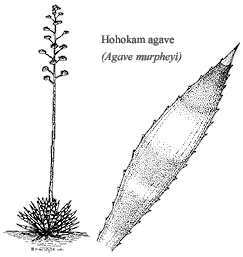
Agave murpheyi
English name: Hohokam agave, Murphey's agave
Spanish name: maguey (a general name for many agaves)
Description
This agave consists of freely suckering rosettes to 3 feet (1 m) across of narrow, straight, toothy light-green leaves. It rarely sets seeds, but produces many plantlets (also called bulbils and semillas, or "seeds") on the flowering stalk.
Range
Only a few populations are known in southern Arizona and northern Sonora. Comments The origin of this agave is unknown; all of the populations are associated with ancient Indian sites. It was extensively cultivated for food and fiber by the Hohokam Indians. They planted this species in the desert (and A. delamateri at higher elevations) along low rock check-dams built on bajadas to slow runoff and increase water penetration. Hundreds of thousands of acres of habitat were modified in this way before the Hohokam culture dispersed 800 years ago. The check-dams and associ-ated roasting pits and agave harvesting tools are still abundant, and in a few sites colonies of the agave survive to this day. All of the populations from Caborca, Sonora, to New River, Arizona, are so similar that they may be one genetic clone. Proof of this would further substantiate the plant's cultural dispersal as one of the few domesti-cated north of Mesoamerica.
Agave schottii
English name: shindagger
Spanish names: amole, maguey, amolillo
Description
The narrow, straight leaves-up to a foot (30 cm) long
in small rosettes-have no marginal teeth, but are very sharp-tipped, hence
the English vernacular name. Shindagger suckers profusely to form dense
colonies that sometimes merge with others and cover many acres (hectares).
The inflorescence is a narrow spike 6 to 8 feet (2-2.4 m) tall, bearing
long-tubular, fragrant yellow flowers. 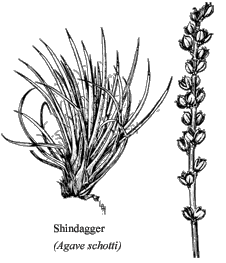
Range
It grows in southern Arizona and northern Sonora, mostly in desert grassland and oak habitats and often on steep, rocky slopes. It is occasionally found in Arizona Upland, e.g., near the summit of the Tucson Mountains.
Comments
There are several other small agaves that may be confused with this species, especially A. felgeri, A. toumeyana, A. polianthiflora, and A. parviflora. The last two are only half as large as A. schottii; A. polianthiflora's flowers are pink to red, while the other 3 have shorter (less than 1¼ inches, 30 mm) flowers.
Agave pelona
English name: none
Spanish name: mescal pelón
(bald agave)
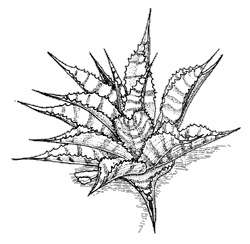 (Agave zebra) |
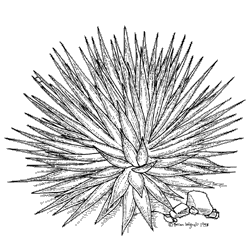 |
Agave zebra
English name: zebra agave
Spanish name: none
Description
Agave pelona: The dense rosette of narrow, toothless leaves is dark blue-green or yellow-green, 2 to 4 feet (0.6-1.2 m) across. A long reddish spine tips each leaf. Since they do not cluster, the singular rosettes are very symmetrical. The flowers are an unusual deep reddish-purple; they're borne on a tall, unbranched spike in the spring.
Agave zebra: These rosettes-3 to 4 feet (1-1.2 m) across-do sucker. The light gray, strongly silver-banded and spine-imprinted leaves are stiff, channeled (folded into a "V"-shape in cross section), and usually strongly recurved. The grayish flowers are borne on a tall, narrow main stem (panicle).
Range
These two species are described together partly because they are both narrowly endemic to the Sierra del Viejo and Cerro Aquituni southwest of Caborca, Sonora. They grow intermingled on steep limestone slopes, where their different growth forms contrast dramatically.
Comments
The other reason these two are grouped is because they share similar past and present uses. Apparently neither species was much harvested by local peoples for traditional ethno-botanical uses. But their rarity and beauty has given both of them value in the new ethnobotany of aesthetic horticulture, where their popularity increases among succulent collectors.